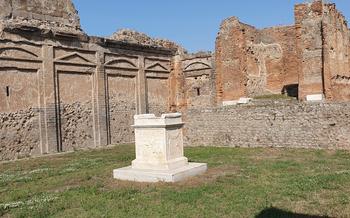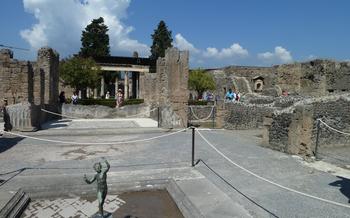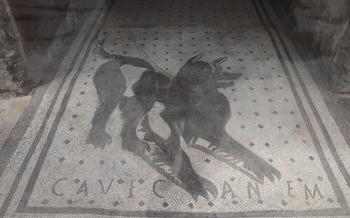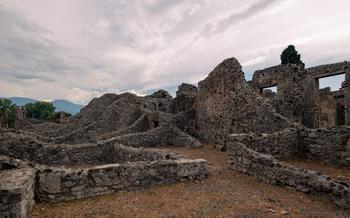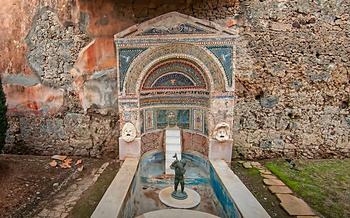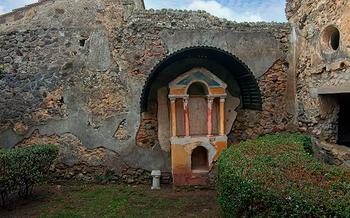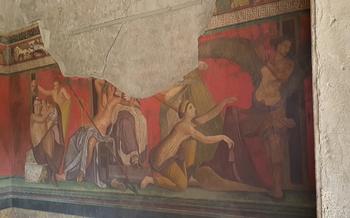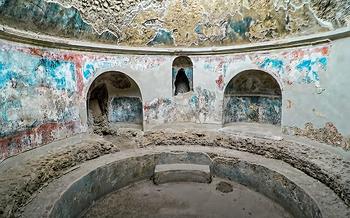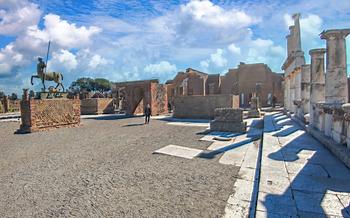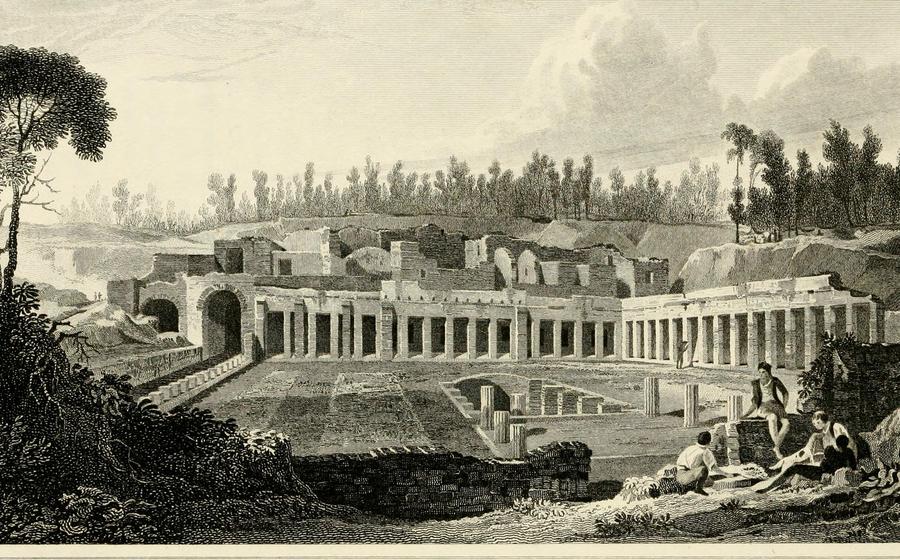
House of the Gladiators
- Pompeii and the House of the Gladiators: A Journey Through History
- Historical Significance
- Layout and Design
- Artifacts and Discoveries
- Frescoes and Mosaics: A Glimpse into the Roman Psyche
- Gladiatorial Training
- Daily Lives
- Gladiatorial Contests
- Impact of the Eruption
- Archaeological Excavations
- Visiting the House of the Gladiators
- Nearby Attractions
- Cultural Significance
- Insider Tip:
Pompeii and the House of the Gladiators: A Journey Through History
Pompeii, an ancient Roman city located near Naples, Italy, is a captivating destination that offers a glimpse into the daily lives and culture of the ancient Romans. Tragically destroyed by the eruption of Mount Vesuvius in 79 AD, Pompeii was buried under layers of ash and pumice, preserving its ruins and artifacts remarkably well. Among the many fascinating sites to explore in Pompeii is the House of the Gladiators, a unique training school and living quarters for gladiators—the fierce warriors who fought in the brutal contests of the Roman arena.
Historical Significance
Gladiators played a significant role in ancient Roman culture.
Layout and Design
The House of the Gladiators boasts an intriguing architectural layout that reflects the gladiators' daily lives and routines. It revolves around a large central courtyard, which served as the primary training ground. The courtyard is surrounded by a series of porticoes, which provided shade and shelter during intense training sessions.
Within the house, you'll find a variety of rooms dedicated to specific purposes. The kitchen, equipped with a large oven and cooking utensils, provided sustenance for the gladiators. The dining room, with its long tables and benches, was a communal space where the gladiators shared meals and socialized. The sleeping quarters, typically small and simple, accommodated the large number of gladiators living in the house.
These interconnected spaces offer a glimpse into the daily lives of the gladiators and the strict discipline that governed their existence. The functional layout of the house reflects the gladiators' primary focus on training and preparation for their often-lethal contests in the arena.
Artifacts and Discoveries
The archaeological excavations at the House of the Gladiators have unearthed a wealth of significant artifacts that provide valuable insights into the lives and training of the gladiators. Among the most notable discoveries are a collection of gladiatorial weapons, including swords, helmets, and shields, which offer tangible evidence of the fierce contests that took place in the amphitheater.
Additionally, training equipment such as weights, punching bags, and wooden practice swords have been found, shedding light on the rigorous physical conditioning and combat techniques that the gladiators underwent. These artifacts provide a unique glimpse into the daily lives of the gladiators, allowing us to better understand their training regimens and the challenges they faced.
In recent years, ongoing research at the House of the Gladiators has focused on uncovering more information about the gladiators' personal lives and social status. Through the analysis of skeletal remains and inscriptions, researchers have gained insights into the gladiators' origins, their health conditions, and their relationships with each other and with the wider community of Pompeii. These discoveries continue to enrich our understanding of the complex and fascinating world of the gladiators.
Frescoes and Mosaics: A Glimpse into the Roman Psyche
The House of the Gladiators is adorned with exquisite frescoes and mosaics that offer a vibrant glimpse into the culture and beliefs of the ancient Romans. These artworks, remarkably preserved by the volcanic ash, depict scenes from gladiatorial contests, mythological stories, and everyday life.
The frescoes, painted on the walls of the house, showcase the artistic prowess of Roman artists. They capture the intensity and drama of gladiatorial combat, with gladiators locked in fierce battles, wielding swords, nets, and tridents. The expressions on their faces convey a range of emotions, from determination and courage to fear and agony.
The mosaics, composed of colorful tiles, adorn the floors of the house, creating intricate patterns and scenes. They depict mythological stories, such as the labors of Hercules and the battle between gods and giants. These mosaics not only serve as decorative elements but also provide insights into the religious beliefs and cultural values of the ancient Romans.
One particularly notable fresco in the House of the Gladiators is the "Triclinium of the Net Hunter," which depicts a gladiator armed with a net and a trident, engaged in a fight with a bull. The fresco is remarkable for its vivid colors and dynamic composition, capturing the tension and excitement of the gladiatorial contest.
These frescoes and mosaics offer a unique opportunity to understand the Roman fascination with gladiatorial contests, their reverence for mythology, and their artistic sensibilities. They provide a glimpse into the minds and hearts of the ancient Romans, allowing us to connect with their culture and values across the centuries.
Gladiatorial Training
Gladiators underwent rigorous training to prepare for their brutal contests. Their daily routine involved intense physical exercises, combat techniques, and weapon handling. The training regimen was designed to develop their strength, agility, and endurance, as well as their skills in wielding various weapons. Different types of gladiators had specialized training methods. For example, the retiarius, who fought with a net and trident, practiced throwing and maneuvering with these weapons. The murmillo, equipped with a shield and sword, focused on close-quarters combat and defense. The thraex, armed with a small round shield and a short sword, trained in both offensive and defensive techniques.
Evidence found at the House of the Gladiators sheds light on their training practices. Training rooms within the house feature wall paintings depicting gladiators engaged in various exercises and drills. These paintings provide valuable insights into the techniques and methods used by the gladiators to hone their skills. Additionally, the discovery of training equipment, such as wooden swords, practice shields, and weighted balls, further supports the notion that the House of the Gladiators served as a comprehensive training facility for these ancient warriors.
Daily Lives
The gladiators lived in the House of the Gladiators in conditions that were both harsh and spartan. They slept in small, cramped rooms, often sharing a bed with another gladiator. Their meals were basic and consisted of simple fare such as bread, cheese, and vegetables. In their free time, the gladiators would often train, practice their combat skills, or relax and socialize with their fellow gladiators.
The gladiators were a diverse group of men, coming from all over the Roman Empire. Some were slaves, others were criminals, and still others were free men who had chosen to become gladiators. Despite their different backgrounds, the gladiators shared a common bond: they were all fighters, and they all faced the same risks and dangers in the arena.
The social hierarchy among the gladiators was strict. The most experienced and successful gladiators were at the top, while the new and inexperienced gladiators were at the bottom. The trainers and managers of the gladiators held the highest positions, and they had the power to decide who would fight, who would train, and who would be punished.
Despite the harsh conditions and the dangers they faced, the gladiators were often respected by the Roman public. They were seen as brave and skilled warriors, and their fights were eagerly anticipated by the crowds. The gladiators were also a source of entertainment for the Romans, and their contests were often used to celebrate important events or to commemorate victories in battle.
Gladiatorial Contests
Pompeii's amphitheater, located just outside the city walls, was the stage for thrilling and deadly gladiatorial contests. These events were a fundamental part of Roman culture, combining entertainment, politics, and social control. Gladiators, often slaves, criminals, or prisoners of war, were pitted against each other in fierce battles to the death. The contests were governed by strict rules and regulations, with different types of gladiators using specialized weapons and techniques. They fought with swords, spears, nets, and tridents, aiming to defeat their opponents while entertaining the bloodthirsty crowds.
The contests served various purposes. They provided a spectacle for the masses, diverting their attention from political and social issues. They also functioned as a means of public execution, punishing criminals and dissidents. Furthermore, they reinforced the dominance of the Roman elite, demonstrating their power and control over life and death.
The House of the Gladiators offers tangible evidence of these gladiatorial contests. Weapons, armor, and training equipment discovered at the site provide insights into the gladiators' preparation and the nature of the fights. These artifacts, along with the well-preserved frescoes depicting gladiatorial scenes, help us reconstruct the atmosphere and intensity of these ancient spectacles.
Impact of the Eruption
The eruption of Mount Vesuvius in 79 AD had a devastating impact on Pompeii and its inhabitants, including the gladiators living in the House of the Gladiators. The catastrophic event unfolded swiftly, leaving little time for escape or preparation. Archaeological evidence suggests that the gladiators were caught unaware by the eruption, as evidenced by the discovery of skeletal remains and personal belongings scattered throughout the house.
The sudden influx of volcanic ash and pumice rapidly buried the House of the Gladiators and its surroundings, preserving the site in a remarkable state of completeness. The ash and pumice acted as a protective layer, sealing and safeguarding the house's contents from the elements and subsequent looting.
This remarkable preservation has allowed archaeologists to gain unprecedented insights into the lives of the gladiators and the ancient Roman world. The House of the Gladiators stands as a testament to the power of nature and the fragility of human existence, while also providing a valuable window into the past.
Archaeological Excavations
The archaeological excavations at the House of the Gladiators have played a crucial role in revealing the history and significance of this unique site. The initial excavations were conducted in the 18th century, uncovering a wealth of artifacts and structural remains that provided the first glimpses into the lives of the gladiators. However, it was not until the 20th century that more systematic and extensive excavations were undertaken, led by renowned archaeologists such as Amedeo Maiuri and Fausto Zevi.
These later excavations brought to light the intricate layout of the House of the Gladiators, revealing its various rooms, training areas, and living quarters. The discovery of numerous gladiatorial weapons, armor, and training equipment provided valuable insights into their training practices and combat techniques. Additionally, frescoes and mosaics depicting gladiatorial contests and mythological scenes further enriched our understanding of the culture and beliefs of the ancient Romans.
One of the most significant challenges faced by archaeologists at the House of the Gladiators was the fragile nature of the ruins. The eruption of Mount Vesuvius buried the city under layers of ash and pumice, preserving it remarkably well, but also making it susceptible to damage during excavation. To address this, archaeologists employed careful techniques, such as gradual removal of debris and the use of protective scaffolding, to ensure the preservation of the site's integrity.
Over the years, the excavations at the House of the Gladiators have yielded numerous important discoveries, including weapons, armor, training equipment, frescoes, and mosaics. These findings have contributed significantly to our understanding of gladiatorial life, ancient Roman culture, and the impact of the eruption of Mount Vesuvius on Pompeii. Ongoing excavations continue to reveal new insights into this fascinating site, shedding light on the lives of the gladiators and the complex society in which they lived.
Visiting the House of the Gladiators
Visiting the House of the Gladiators is a unique and immersive experience that allows visitors to step back in time and explore the lives of these ancient warriors. The house is open to the public, and guided tours are available to provide insights into the history, culture, and daily lives of the gladiators. Visitors can wander through the various rooms of the house, including the training rooms, living quarters, and kitchen, and admire the well-preserved frescoes and mosaics that adorn the walls. The site also features a museum that displays artifacts discovered during the excavations, such as weapons, armor, and training equipment, which provide further insights into the lives of the gladiators. Visitors should plan to spend at least an hour exploring the House of the Gladiators and the museum to fully appreciate the significance and history of this fascinating place.
Nearby Attractions
The House of the Gladiators is just one of many fascinating attractions in Pompeii. For a comprehensive exploration of the ancient city, visitors should also consider exploring the following nearby attractions:
- Amphitheater: This well-preserved amphitheater was the site of gladiatorial contests and other public spectacles. It could accommodate up to 20,000 spectators and is one of the largest and best-preserved Roman amphitheaters in the world.
- Forum: The forum was the heart of ancient Pompeii, serving as a marketplace, meeting place, and center of political and religious life. Visitors can explore the ruins of temples, shops, and government buildings, as well as the famous Temple of Apollo.
- Temple of Apollo: This well-preserved temple is one of the oldest and most important religious buildings in Pompeii. Dedicated to the god Apollo, the temple features impressive columns, sculptures, and frescoes.
- Villa of the Mysteries: This luxurious villa is known for its stunning frescoes, which depict scenes from the cult of Dionysus. The villa also features beautiful gardens, mosaics, and sculptures.
To make the most of your visit to Pompeii, consider purchasing a combination ticket that grants access to multiple attractions, including the House of the Gladiators. You can also book a guided tour to learn more about the history and significance of the site.
Cultural Significance
The House of the Gladiators stands as a testament to the complex and often brutal realities of ancient Roman culture. It offers a unique perspective on the lives of these men who were both celebrated and feared, and whose existence was a stark reminder of the power and spectacle of ancient Rome.
Preserving and protecting this site is of paramount importance, as it serves as a valuable resource for understanding the complexities of ancient society. Through ongoing research and education, we can continue to unravel the stories of the gladiators and gain insights into the societal attitudes and norms that shaped their world.
Various initiatives are underway to promote the cultural heritage of Pompeii and the House of the Gladiators. Archaeological research, restoration projects, and public outreach programs play a crucial role in ensuring that this unique site remains accessible and meaningful to visitors from around the world.
By exploring the House of the Gladiators, we not only gain a glimpse into the past but also confront the complexities of human nature and the enduring legacy of ancient Rome. It is a place that invites contemplation, empathy, and a deeper understanding of the human experience across time.
Insider Tip:
For a unique and immersive experience, consider visiting the House of the Gladiators during the annual "Gladiators' Day" event, which typically takes place in the summer months. This special event recreates the atmosphere of a gladiatorial contest, with costumed gladiators demonstrating combat techniques and engaging in mock battles. Visitors can witness these thrilling performances, learn more about the history and culture of gladiators, and even participate in hands-on activities such as gladiator training drills. Check the official website of the Pompeii Archaeological Park for dates and details of the event.
